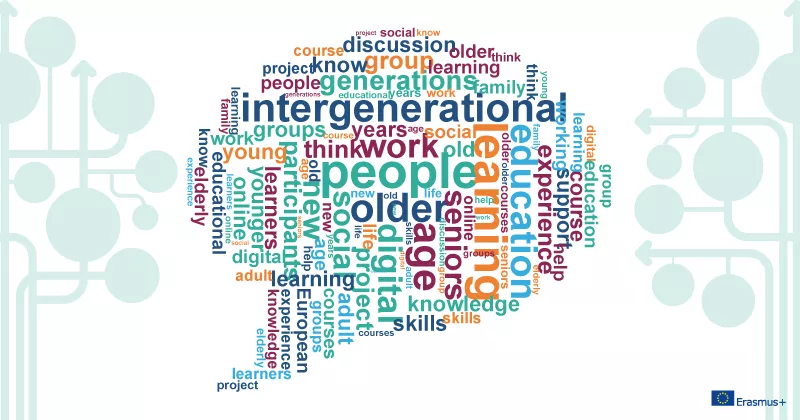Social inclusion of the ageing population: summary of the discussion's contributions

During the online discussion on the social inclusion of the ageing population and intergenerational learning EPALE hosted lots of interesting and relevant contributions from its community. Let's have a look on what happened!
Examples of outreach activities and engaging older people in learning
- There’s a great need to increase providers' knowledge of how to plan, deliver, monitor, and evaluate intergenerational programmes. It is also important for policy-makers to understand the benefits this approach can have on communities and why it should be a core element in all areas of local and national governments.
- Older learners can benefit from various opportunities but also be valid contributors.
- The interpretation of lifelong learning and intergenerational learning differ in different cultures and contexts. The history of the different generations in each country is important to know to understand each other. The rural context tends to focus more on the family than urban.
- The Erasmus+ project called "Bridge" aiming to create serious games targeting cognitive and behavioural symptoms of dementia through workshops engaging younger and elders.
- Older people have a right to get support when it comes to using new media in a competent and self-determined way. It is about the right to take an active part in social life.
- Adult educators need to recognize and work closely with the so-called 'intermediaries'. So, agencies and community organizations that have the trust of older people and need to get recognized for playing a vital role in engaging them. ALE policies and initiatives should get directed towards removing barriers that exclude the elderly. In times of social isolation, the importance of learning in older age is more visible and revealed existing gaps. As most events are online, e-illiterate elderly get excluded. The process of engaging older people should start before retirement. Knowledge around retirement, their options, how to stay included, etc. Slovenian example: Pre-retirement seminars.
- Conversation courses as ideal settings for discussing issues that affect all of us. The more diverse the group is, the better. People are more than willing to talk about deeply personal experiences when the subject is broached creatively. Society functions best when all voices are equally heard.
- The planning and execution of offers/courses have to be done in a way that older persons have a say in what and how they learn. They are the owners of their learning processes and biographies. Providers should listen to what older people say about the learning processes. (Example from participants who expressed the need for a bike riding course. When offered, it led to higher motivation and participation).
- We should not teach differently for different ages. Teaching "without age" and across generations brings greater benefits. Example of Danish Folk High Schools, where short courses are addressed to mixed generations. Learning methods have age, learning has not.
- Utena Third Age University and Utena Public Library (Lithuania) help mainly improve people’s digital competences by following the "family learning" method. Families (across generations) learn together. It is a comfortable first step for many older people to enter further education and offers a dual effect.
COVID-19 and older learners
Physical distancing does not mean social distancing. Older and younger people can come together, learn from each other, exchange ideas, experiences, and knowledge.
- Even though the COVID-19 crisis brought a lot of impacts, it highlighted that the generations need each other, not only for their education but also for life balance.
- Initiatives that focus on old people need to be re-arranged by building a strong methodology regarding our new digital experiences.
- A community story from Finland highlights the significance of the collaborative digital learning of older people during the period of isolation.
- There is a fear that the pandemic will reduce intergenerational learning to catching up on the digital skills of seniors. Older people must interact with younger ones, learn from each other, and benefit from their experience. It is significant to highlight the content of knowledge and the experiences that older people can pass on to younger.
- The interaction of older people with younger ones is crucial for everyone’s well-being. COVID-19 brought some changes and here as well.
Experiences & examples of working with the 4th age
- Adult learning and education can also make a significant difference for very old people (4th Age), for example in care homes.
- We heard the example of a ‘computer breakfast’ where older people interact with each other. The atmosphere has to be relaxed and inviting.
- Civic involvement is greater in issues that affect people's immediate surroundings e.g. living environment, local cultural heritage, and so on.
- Inspiration can be provided by the results of the European Year for Active Ageing and Solidarity between generations (2012).
How to ensure the active social participation of adults? What should be the role of ALE providers? What support is needed?
- It is important to cooperate with other organizations/bodies, such as care homes, doctors, social workers, and so on. Working WITH older people and taking their needs and voice into consideration is essential for a high-quality offer. The learning environment also needs to be accessible to older people.
- It can be very fruitful to include people from different age range in common activities/projects.
- Different ages/groups of people can have different expectations from a course. This needs to be taken into consideration by providers and trainers.
- New methodologies should be developed and used to be more learner-centred and successful.
[Summary by Dimitrios Charmpis and Gina Ebner]





retraite, nouvelles carrière et profession, travail